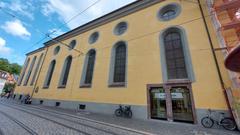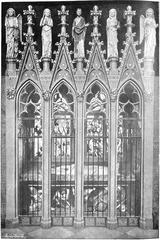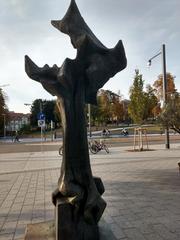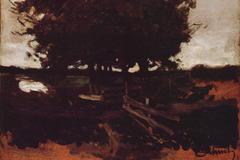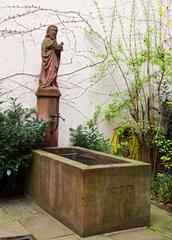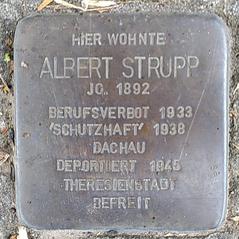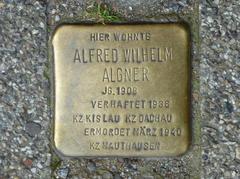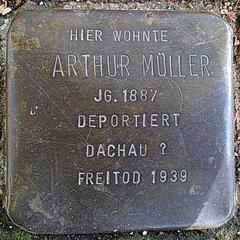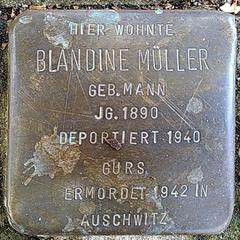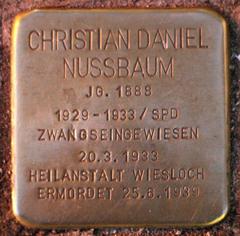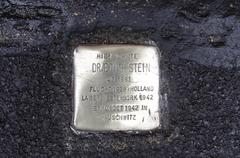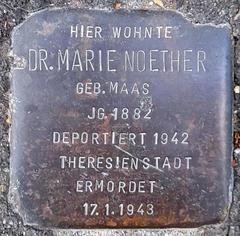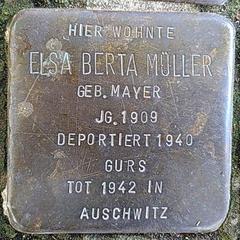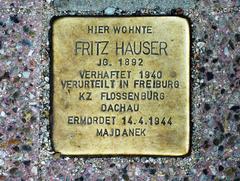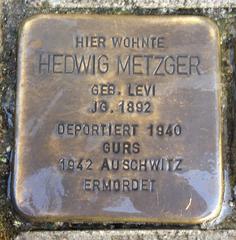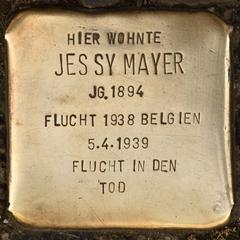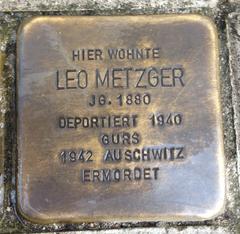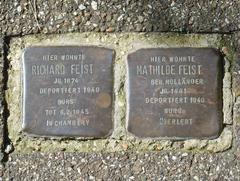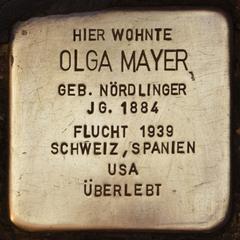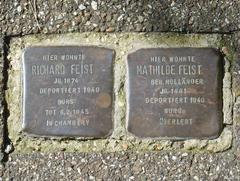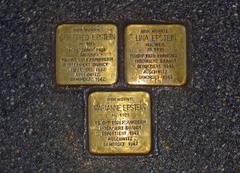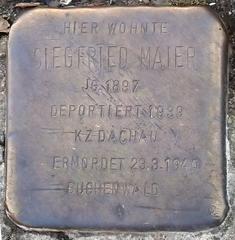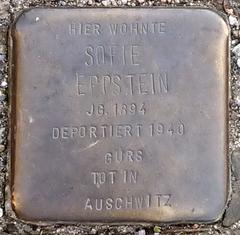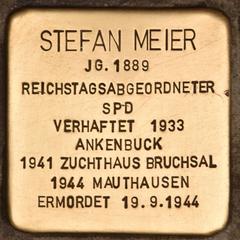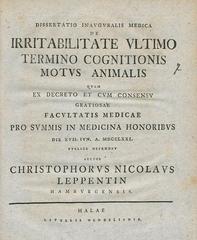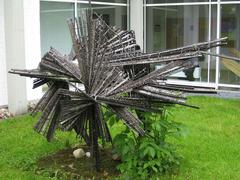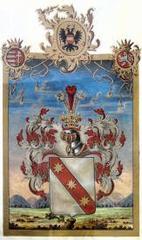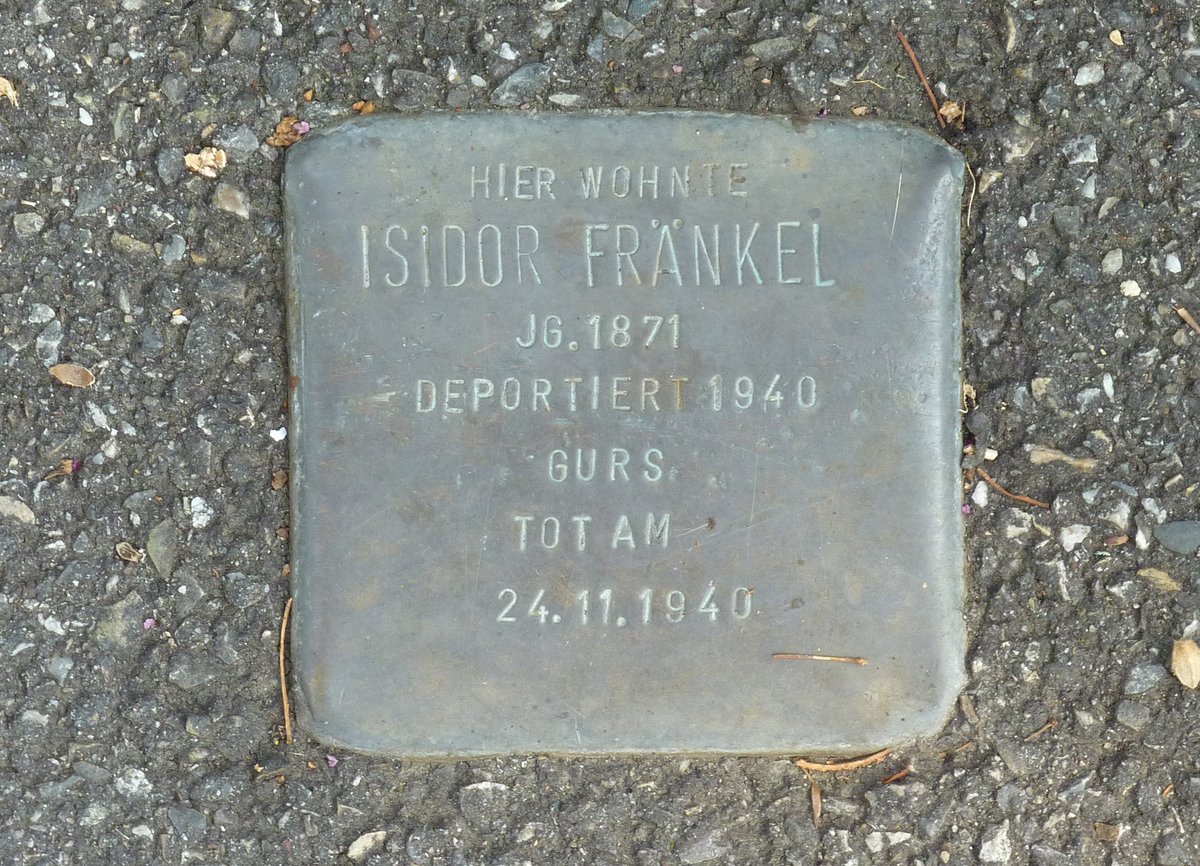
Stolperstein Isidor Fränkel Freiburg: Visiting Hours, Tickets, and Visitor Guide
Date: 14/06/2025
Introduction
Walking through Freiburg im Breisgau, visitors encounter a unique and deeply personal form of remembrance: the Stolpersteine, or “stumbling stones.” These small brass plaques, embedded in city sidewalks, commemorate individual victims of Nazi persecution by marking their last freely chosen residences. Among these is the Stolperstein dedicated to Isidor Fränkel, a Jewish resident whose life and fate reflect the city’s Jewish history and the tragic impact of the Holocaust. This comprehensive visitor guide provides historical context, cultural significance, and practical information for those wishing to honor Isidor Fränkel and explore the broader Stolpersteine project in Freiburg.
The Stolpersteine Project: Origins and Philosophy
Initiated by German artist Gunter Demnig in 1992, the Stolpersteine project is the world’s largest decentralized memorial to victims of National Socialism. Each Stolperstein—a 10 x 10 cm brass-plated concrete block—bears the inscription “Here lived,” followed by the victim’s name, date of birth, fate, and, when known, date and place of death. The intention is to restore the identities of Holocaust victims, bringing remembrance into the everyday lives of passersby (stolpersteine.eu; pragueviews.com).
Rather than forming a single, centralized monument, the project embeds memory directly into the urban environment. As of 2025, over 100,000 Stolpersteine have been installed in more than 26 countries. The project commemorates Jews, Sinti and Roma, political prisoners, people with disabilities, LGBTQ+ individuals, Jehovah’s Witnesses, and others persecuted by the Nazis. Its guiding principle is to ensure that “a person is only forgotten when their name is forgotten,” restoring dignity and identity to each victim (artsandculture.google.com; germany.info).
Stolpersteine in Freiburg: Local History and Community Involvement
Freiburg’s engagement with the Stolpersteine project began in the early 2000s. Local historians, schools, and community organizations research victim biographies, sponsor stones, and coordinate with the Stolpersteine Foundation for installations. The city now features hundreds of Stolpersteine, each marking a story of loss and resilience (stolpersteine-in-freiburg.de).
Community involvement is central: installations are often accompanied by ceremonies, and residents regularly clean and maintain the stones, particularly on Holocaust Remembrance Day. This ongoing engagement transforms the stones from static markers into living sites of memory (pragueviews.com; folklife.si.edu).
Isidor Fränkel: Life, Persecution, and Memorialization
Biography
Isidor Fränkel was born on June 11, 1871, in Uhrspringen (now Urspringen). He lived in Freiburg, where he managed a dowry and linen business with his wife, Delphine Fränkel (née Kahn). Under Nazi pressure, the family was forced to close their business; its inventory was auctioned in 1937, and the business was removed from the register shortly after. On October 22, 1940, Isidor Fränkel was arrested during the mass deportations in Baden and sent to the Gurs internment camp in France. He died there on November 24, 1940, only four weeks after his arrival, at the age of 69 (stolpersteine-in-freiburg.de).
The Stolperstein for Isidor Fränkel
Isidor Fränkel’s Stolperstein is located in front of his last freely chosen residence in Freiburg’s Herdern district, at Schlüsselstraße 23 (tracesofwar.nl; mapcarta.com). The inscription follows the standard Stolperstein format, detailing his name, birth, deportation, and fate. Its placement at the threshold of his former home personalizes remembrance and reconnects the memory of the victim with the daily life of the city (de.wikipedia.org).
Visiting the Isidor Fränkel Stolperstein
Location & Accessibility
The Stolperstein is embedded in the sidewalk at Schlüsselstraße 23, Herdern, Freiburg. As with all Stolpersteine, it is accessible 24/7 and is free to visit—no tickets or reservations are necessary. Most stones are set flush with the pavement, making them accessible to visitors with mobility challenges, though some areas may have uneven surfaces (stolpersteine-in-freiburg.de).
Getting There
Freiburg’s efficient public transportation system makes reaching the Herdern district straightforward. From the main train station (Hauptbahnhof), take tram line 1 or 3 to the city center and walk to Schlüsselstraße. Local tourist information offices and websites provide maps and additional directions (visit.freiburg.de).
Guided Tours and Walking Routes
Local organizations and museums offer guided tours focusing on Freiburg’s Jewish history and Stolpersteine locations. These tours often provide deeper insight into the stories behind each stone, including Isidor Fränkel’s. Maps and digital guides are available from the Freiburg Tourist Office and the Stolpersteine in Freiburg website.
Nearby Historical Sites
Visitors can also explore other Holocaust-related sites in Freiburg, such as the former synagogue memorial, the Jewish cemetery, and the Freiburg Historical Museum. These landmarks offer a broader context for understanding the city’s Jewish heritage and the impact of Nazi persecution.
Visitor Etiquette and Tips
- Pause and Reflect: Take a moment to read the inscription and honor the individual.
- Avoid Stepping on the Stone: As a mark of respect, do not stand directly on the Stolperstein.
- Maintain Quiet: Keep noise to a minimum and respect the contemplative nature of the site.
- Photography: Discreet photography is permitted; avoid obstructing the sidewalk or taking casual selfies.
- Tokens of Remembrance: It is customary to leave small stones or flowers on the Stolperstein.
- Support and Report: If you notice a damaged or missing stone, contact the Stolpersteine Freiburg project.
Cultural and Educational Significance
Stolpersteine are more than just markers—they are living memorials that bring history into the public sphere and challenge indifference. The experience of encountering a Stolperstein is meant to provoke reflection, empathy, and dialogue. In Freiburg, these stones represent a community’s ongoing commitment to remembrance and education, embodied in ceremonies, school projects, and public events (folklife.si.edu; academia.edu).
While widely embraced, the project has not been without controversy. Some critics are uncomfortable with the idea of memorials being “trampled underfoot,” leading cities like Munich to opt for alternative memorial forms. Nonetheless, the broad participation and continued expansion of the Stolpersteine project underscore its significance as a tool for education, memory, and moral reflection (artsandculture.google.com).
Frequently Asked Questions (FAQ)
Where is the Isidor Fränkel Stolperstein located?
In front of Fränkel’s last residence at Schlüsselstraße 23, Herdern, Freiburg. For precise directions, consult the Stolpersteine Freiburg website.
Are there tickets or visiting hours?
No. The Stolperstein is accessible outdoors 24/7, free of charge.
How do I get there using public transport?
Tram lines and buses serve the Herdern district. Maps and route planners are available via the city’s public transport website or at the tourist office.
Can I leave flowers or stones at the site?
Yes. Leaving small tokens is a respectful way to honor the memory of the victim.
Is the site accessible for people with disabilities?
Most Stolpersteine are accessible, though some areas have uneven pavement. Plan accordingly.
Summary and Visitor Recommendations
Visiting the Stolperstein for Isidor Fränkel in Freiburg is a powerful, personal way to engage with Holocaust memory. The site is accessible year-round, free to visit, and integrated into the city’s everyday landscape—inviting reflection, respect, and remembrance. Visitors are encouraged to explore other related historical sites, participate in guided tours, and support ongoing remembrance initiatives.
By encountering Isidor Fränkel’s Stolperstein, you participate in a broader dialogue about memory, responsibility, and the enduring impact of the Holocaust. These decentralized memorials ensure that names and stories are not lost to history and serve as a call to vigilance against intolerance.
For maps, guided tour bookings, and educational resources, visit the Stolpersteine Freiburg website. To enrich your experience, download the Audiala app for interactive tours and further historical context.
Sources and Further Reading
- This is a sample text. (stolpersteine.eu)
- This is a sample text. (pragueviews.com)
- This is a sample text. (artsandculture.google.com)
- This is a sample text. (germany.info)
- This is a sample text. (folklife.si.edu)
- This is a sample text. (stolpersteine-in-freiburg.de)
- This is a sample text. (tracesofwar.nl)
- This is a sample text. (mapcarta.com)
- This is a sample text. (de.wikipedia.org)
- This is a sample text. (visit.freiburg.de)
- This is a sample text. (academia.edu)
- This is a sample text. (tappedouttravellers.com)

